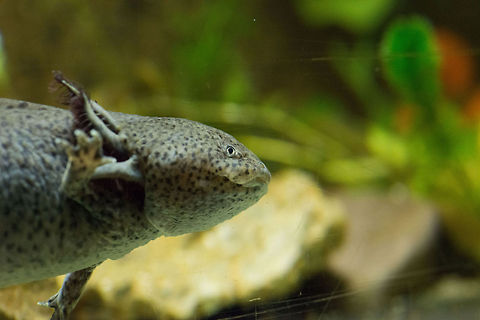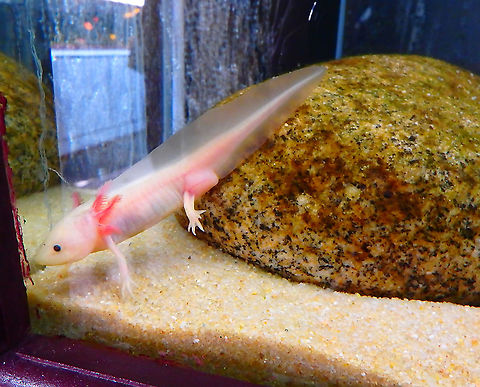
Appearance
A sexually mature adult axolotl, at age 18–24 months, ranges in length from 15–45 cm, although a size close to 23 cm is most common and greater than 30 cm is rare. Axolotls possess features typical of salamander larvae, including external gills and a caudal fin extending from behind the head to the vent.Their heads are wide, and their eyes are lidless. Their limbs are underdeveloped and possess long, thin digits. Males are identified by their swollen cloacae lined with papillae, while females are noticeable for their wider bodies full of eggs. Three pairs of external gill stalks originate behind their heads and are used to move oxygenated water. The external gill rami are lined with filaments to increase surface area for gas exchange. Four gill slits lined with gill rakers are hidden underneath the external gills.
Axolotls have barely visible vestigial teeth, which would have developed during metamorphosis. The primary method of feeding is by suction, during which their rakers interlock to close the gill slits. External gills are used for respiration, although buccal pumping may also be used to provide oxygen to their lungs. Axolotls have four different colours, including two mutant colors. The two normal colors are "wildtype" and melanoid. The two mutant colors are leucistic and albino.

Distribution
The axolotl is only native to Lake Xochimilco and Lake Chalco in central Mexico. Unfortunately for the axolotl, Lake Chalco no longer exists, as it was artificially drained to avoid periodic flooding, and Lake Xochimilco remains a remnant of its former self, existing mainly as canals. The water temperature in Xochimilco rarely rises above 20 °C , though it may fall to 6 to 7°C in the winter, and perhaps lower.The wild population has been put under heavy pressure by the growth of Mexico City. The axolotl is currently on the International Union for Conservation of Nature's annual Red List of threatened species. Non-native fish, such as African tilapia and Asian carp, have also recently been introduced to the waters. These new fish have been eating the axolotls' young, as well as its primary source of food.
Habitat
Axolotls are members of the ''Ambystoma tigrinum'' complex, along with all other Mexican species of ''Ambystoma.'' Their habitat is like that of most neotenic species—a high altitude body of water surrounded by a risky terrestrial environment. These conditions are thought to favor neoteny. However, a terrestrial population of Mexican Tiger Salamanders occupies and breeds in the axolotl's habitat.Food
The axolotl is carnivorous, consuming small prey such as worms, insects, and small fish in the wild. Axolotls locate food by smell, and will "snap" at any potential meal, sucking the food into their stomachs with vacuum force.References:
Some text fragments are auto parsed from Wikipedia.